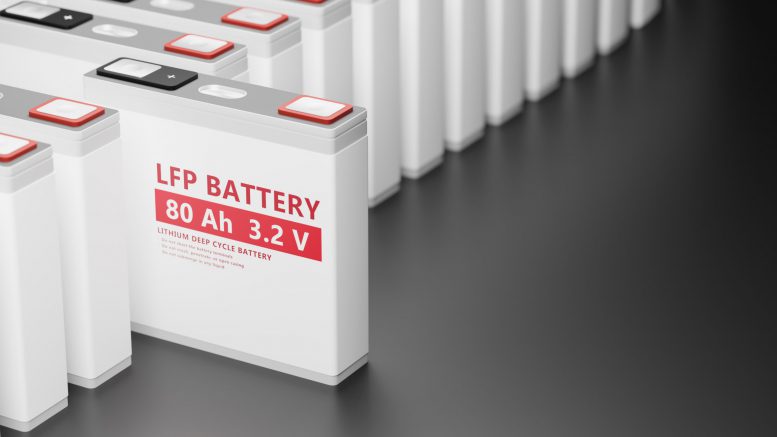First Phosphate (CSE: PHOS; US-OTC: FRSPF) has posted an initial phosphate resource for its Bégin-Lamarche project in Quebec after choosing a plant site to process the material for lithium iron phosphate (LFP) batteries.
Bégin-Lamarche, one of the company’s two projects in the Saguenay-Lac-St-Jean region, holds 41.5 million indicated pit-constrained tonnes grading 6.49% phosphate (P2O5) and 214 million inferred pit-constrained tonnes at 6.01% P2O5, the company said Sept. 18. The site’s Mountain zone adds 3 million indicated tonnes at 8.19% P2O5 and 6.8 million inferred tonnes grading 8.57% P2O5.
The company said last week it plans to build a 10,000-tonne-per-year iron phosphate plant 20 km from the deep-sea port of Saguenay. The plant is to serve as part of First Phosphate’s planned vertically integrated operation, transforming phosphate from its proposed mines into cathode active material (CAM). First output for the batteries that power about three-quarters of electric vehicles is expected in early 2026.
The company aims to make battery-grade phosphoric acid from igneous rock, which is confined to a few accessible places in the West, CEO John Passalacqua said during a presentation on Thursday in Toronto. It’s different than the fertilizer type of phosphate that comes from sedimentary deposits.
“This stuff is rarer than gold,” Passalacqua said. “Eighty percent of all the batteries in the world are now LFP. There’s not going to be phosphate anywhere to produce those LFP batteries. Why would I not be bullish?”
Less expensive
While LFP batteries have a lower energy density than lithium-ion batteries, they’ve gained market share because they’re less expensive to produce. Adherents to the battery chemistry include Tesla CEO Elon Musk and Chinese EV giant BYD.
Part of Passalacqua’s argument is that LFP batteries are more popular for less expensive autos than nickel-manganese-cobalt batteries, which will likely remain among higher-end cars and SUVs. The company expects North American demand for LFP CAM to reach 1 million tonnes a year valued at US$24 billion by 2033, with none produced on the continent now. Another plus is that while vehicles take about 20% of supply, 61% goes to long-term energy storage where nickel-manganese-cobalt batteries aren’t used.
The supply of phosphoric acid, which is also used in soft drinks, cereal and fire extinguishers, is at capacity globally but must double by 2045 to meet battery demands, according to research by CRU.
“LFP is so effective, it’s so valuable, it’s so cost effective, that it can meet a whole gamut of means for electrification,” Passalacqua said. “And that’s why we’re in there. We can balance out our risks.”
Lac à l’Orignal
The company’s main phosphate project, Lac à l’Orignal, 84 km from Saguenay, would produce an average of 425,000 tonnes of phosphate concentrate a year with a phosphate content of over 40%, according to a preliminary economic assessment from July 2023. The project would also produce 280,000 tonnes of magnetite and 97,000 tonnes of ilmenite over a 14-year mine life.
It would generate an after-tax net present value at a 5% discount rate of $511 million and an internal rate of return of 17.2%. Pre-production capex was pegged at $550 million with an after-tax payback of just under five years.
The company has a market capitalization of $20.6 million on the CSE. Its shares closed flat Thrusday at 28¢ apiece. They’ve traded in a 52-week range of 15¢ to 48¢.
Lac a l’Original has an open-pit constrained resource of 15.8 million indicated tonnes grading 5.18% phosphate (P2O5), 23.9% iron oxide (Fe2O3) and 4.23% ilmenite. Inferred resources measure 33.2 million tonnes grading 5.06% P2O5, 22.55% Fe2O3 and 4.16% ilmenite.
At Bégin-Lamarche, First Phosphate has discovered four main zones with multiple open-pit accessible phosphate-bearing layers and has completed more than 30,000 metres of drilling over the last year and a half.
The CEO described it as a 2-km long surface deposit where drilling has only pierced to 250 metres and has much further to go.
Plant feed
The proposed plant’s initial feedstock will be sourced from third parties but will eventually come from Bégin-Lamarche as early as 2028, the CEO said. The 28,000-sq.-metre industrial plant, where it has a renewable 10-year lease, requires an estimated US$65 million in retrofitting.
First Phosphate has started a feasibility study with Ultion Technologies to finalize infrastructure requirements. The plant’s technology has already been proven at two other facilities globally, allowing First Saguenay to move directly to large-scale production without a pilot phase.
In January, First Phosphate inked a deal with American Battery Factory of Utah and U.K.-based Integrals Power to produce lithium iron phosphate cathode material and LFP battery cells.
The proposed plant is a few kilometres from Canadian Air Forces NATO Base Bagotville, which during the Second World War helped protect local producers supplying 85% of Allied aluminum for aircraft. German U-boats were said to have fired on the plants, Passalacqua said.
“Now it’s a different equation, but what do we have?” the CEO said. “We’ve got direct logistics down here to Detroit to automaking, with 50 km from where the mine will be is an intermodal station where the trucks get onto the rail cars. We’re packed into all that infrastructure.”


Be the first to comment on "First Phosphate touts battery acid from Quebec rock ‘rarer than gold’"